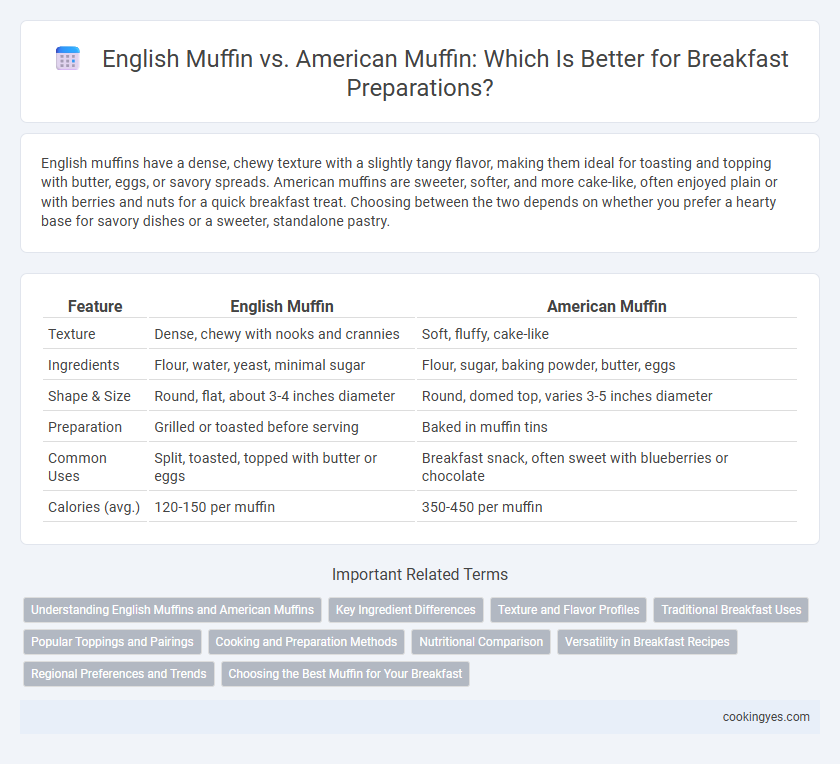English muffins have a dense, chewy texture with a slightly tangy flavor, making them ideal for toasting and topping with butter, eggs, or savory spreads. American muffins are sweeter, softer, and more cake-like, often enjoyed plain or with berries and nuts for a quick breakfast treat. Choosing between the two depends on whether you prefer a hearty base for savory dishes or a sweeter, standalone pastry.
Table of Comparison
| Feature | English Muffin | American Muffin |
|---|---|---|
| Texture | Dense, chewy with nooks and crannies | Soft, fluffy, cake-like |
| Ingredients | Flour, water, yeast, minimal sugar | Flour, sugar, baking powder, butter, eggs |
| Shape & Size | Round, flat, about 3-4 inches diameter | Round, domed top, varies 3-5 inches diameter |
| Preparation | Grilled or toasted before serving | Baked in muffin tins |
| Common Uses | Split, toasted, topped with butter or eggs | Breakfast snack, often sweet with blueberries or chocolate |
| Calories (avg.) | 120-150 per muffin | 350-450 per muffin |
Understanding English Muffins and American Muffins
English muffins are small, round, and flat bread products with a dense, chewy texture and a slightly tangy flavor, often split open and toasted for breakfast sandwiches or served with butter and jam. American muffins, in contrast, are sweeter, cake-like quick breads that come in various flavors such as blueberry or chocolate chip, commonly eaten as a standalone pastry or snack. Understanding the distinct textures, flavors, and uses of English and American muffins helps in selecting the ideal option for different breakfast preparations.
Key Ingredient Differences
English muffins feature a dense, chewy texture achieved from a simple dough primarily made with flour, water, yeast, and malted barley flour, while American muffins incorporate a leavened batter with flour, sugar, eggs, milk, and baking powder or baking soda, resulting in a sweeter, softer crumb. The key ingredient difference lies in the leavening agents: English muffins rely mainly on yeast fermentation, whereas American muffins use chemical leaveners to create their light, cake-like structure. This distinction impacts their flavor profile and suitability for breakfast preparations, with English muffins often toasted and topped with butter, and American muffins commonly served as sweet pastries or snacks.
Texture and Flavor Profiles
English muffins feature a dense, chewy texture with a slightly crisp exterior and a subtle tangy flavor from yeast fermentation, ideal for toasting and topping with butter or jam. American muffins are softer and cake-like, often sweeter with a moist crumb, incorporating ingredients like sugar, oil, and baking powder, making them perfect for a quick, sweet breakfast treat. The contrast in texture and flavor between the English muffin's hearty crust and the American muffin's tender crumb defines their distinct roles in breakfast preparations.
Traditional Breakfast Uses
English muffins feature a dense, chewy texture with nooks and crannies ideal for holding butter and jam, making them a staple in traditional breakfast dishes like Eggs Benedict and toasted breakfast sandwiches. American muffins are sweet, cake-like, and often include fruits or nuts, commonly served as a standalone pastry or with coffee. For classic breakfast preparations, English muffins are preferred due to their savory versatility and ability to complement eggs, bacon, and other breakfast staples.
Popular Toppings and Pairings
English muffins, known for their dense texture and nooks-and-crannies, pair perfectly with classic toppings like butter, jam, and poached eggs for breakfast sandwiches such as Eggs Benedict. American muffins, characterized by their soft crumb and sweetness, are often enjoyed plain or with fruit spreads, nuts, or cream cheese. Popular pairings for English muffins emphasize savory flavors while American muffins lean toward sweet accompaniments, catering to different breakfast preferences.
Cooking and Preparation Methods
English muffins are typically cooked on a griddle or skillet, giving them a dense texture with characteristic nooks and crannies ideal for holding butter and jam. American muffins are baked in a hot oven, resulting in a lighter, cake-like crumb favored for sweet or savory mix-ins. English muffins require splitting and toasting before serving, whereas American muffins are served whole, often topped with icing or streusel.
Nutritional Comparison
English muffins typically contain fewer calories and less sugar compared to American muffins, making them a lighter breakfast option. American muffins often have higher fat content and added sugars, which contribute to increased calorie density but richer flavor and moist texture. For those tracking macronutrients, English muffins offer more protein and fiber per serving, supporting satiety and digestive health.
Versatility in Breakfast Recipes
English muffins offer a unique texture with a crisp exterior and airy interior, making them ideal for savory breakfast dishes like eggs Benedict or breakfast sandwiches. American muffins, typically sweeter and denser, excel as standalone treats or with sweet toppings such as fruit preserves and butter. Choosing between the two depends on whether a versatile base for diverse flavors or a ready-to-eat sweet option is preferred in breakfast preparations.
Regional Preferences and Trends
English muffins are prized for their dense, chewy texture and are often split and toasted to complement toppings like butter, jam, or eggs, making them a breakfast staple in the United Kingdom and parts of Canada. In contrast, American muffins are sweeter, larger, and cake-like, widely favored in the United States as portable, single-serving baked goods with flavors ranging from blueberry to chocolate chip. Regional preferences reflect these differences: English muffins dominate traditional British breakfast menus, while American muffins cater to quick, on-the-go meals popular in North American urban centers.
Choosing the Best Muffin for Your Breakfast
English muffins offer a dense, chewy texture with a slightly tangy flavor, making them ideal for savory breakfast sandwiches or toppings like eggs and cheese. American muffins are sweeter, fluffier, and often baked with fruits or nuts, perfect for a quick, grab-and-go morning treat. Selecting the best muffin depends on whether you prefer a hearty base for savory dishes or a sweet, standalone option to start your day.
English Muffin vs American Muffin for breakfast preparations Infographic

 cookingyes.com
cookingyes.com